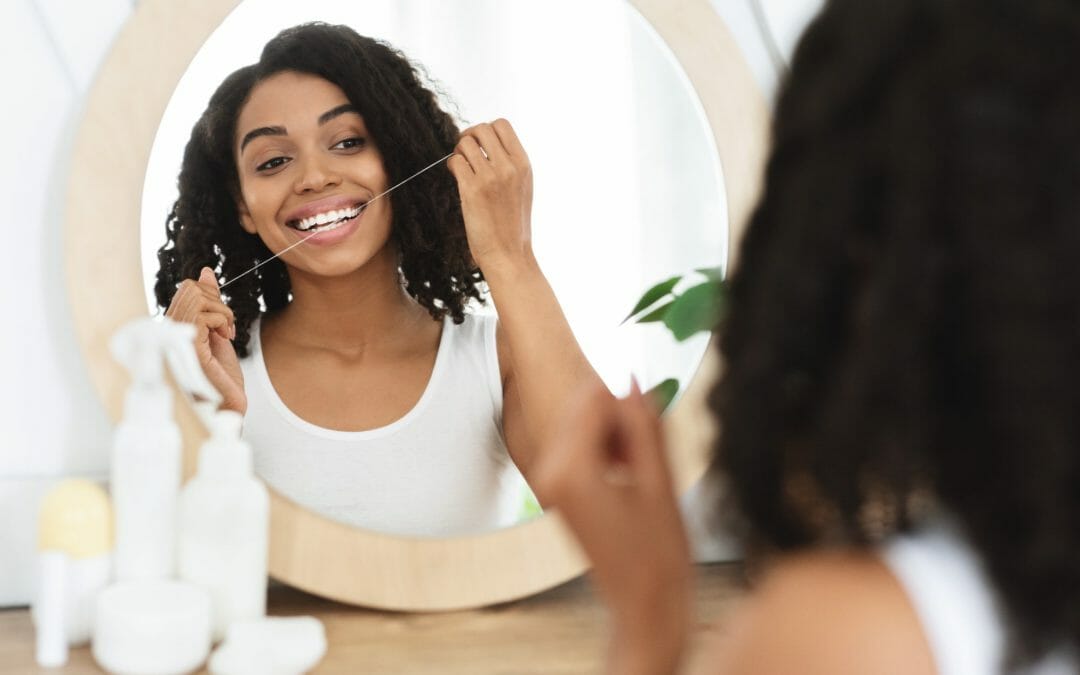Practicing good oral hygiene in between professional dental cleanings is essential to preventing oral health problems from developing and safeguarding your oral health for life. While most patients know that they should brush their teeth twice a day and floss at least once a day, many are not aware of proper oral hygiene techniques. In this article, we’ll take a closer look at flossing to ensure the time you spend flossing your teeth is time well spent.
How to Floss Your Teeth: Proper Flossing Technique
To floss your teeth properly, begin by pulling out and breaking off about 18 to 24 inches of dental floss. Wind both ends of the floss around your middle fingers, leaving no more than one to two inches of floss between your two fingers. Pinch the free floss between your thumbs and index fingers to pull it taught.
Next, position the floss between two teeth and gently glide it up and down, being careful not to hit it roughly against your gums. (This could bruise or cut your delicate gum tissue.) As you move the floss, pull it into a “U” shape and be sure to rub it against the sides of each tooth on either side of the space.
Move from space to space, repeating the above steps. Each time you move to a new space between your teeth, use a clean section of dental floss.
When and How Often to Floss Your Teeth
Most dentists recommend flossing at least once a day because this can have a big impact on a patient’s teeth. You can, however, floss your teeth more often. Many patients floss both in the morning and at night or after every meal to remove food debris from the spaces between their teeth.
If you’re only going to floss once, we recommend flossing before you go to bed. This ensures that while you sleep, the spaces between your teeth are clean and free from any caught food debris. Otherwise, you’ll be spending hours upon hours sleeping while harmful bacteria feast and produce lots of acids that can result in tooth decay.
Should You Floss Before or After You Brush Your Teeth?
Many patients never pause to think about the order in which they complete their oral hygiene routine. It is, however, something that should be carefully considered; the order in which you brush and floss – and use a water flosser, if you choose to incorporate one into your oral hygiene routine – actually makes a fairly big difference in the efficacy and results of your preventive oral care.
The best order is as follows:
- Floss your teeth first to remove and loosen plaque, bacteria, and food debris from between your teeth.
- Next, use your water flosser (if you have one) to remove the debris between your teeth and below your gum line that has already been loosened and not completely removed by your dental floss.
- Finally, brush your teeth.
- If you rinse with mouthwash, do so last.
Waiting to brush your teeth and rinse with mouthwash as the final steps in your oral hygiene routine helps to achieve the most thorough clean possible in your mouth. Additionally, by removing plaque and other debris from between the teeth with dental floss first, you ensure the hard-to-reach areas between your teeth receive the maximum fluoride exposure possible. This helps to remineralize and strengthen tooth enamel in the areas between the teeth where patients are usually most likely to develop tooth decay and cavities.
What Kind of Dental Floss Should You Use?
To ensure the safety of your sensitive gum tissues, choose a dental floss that has been approved by the American Dental Association. Other than that one recommendation, the type of dental floss you use is largely left up to personal preference. You can choose between waxed and unwaxed varieties, flosses of different weights (thickness), unflavored or flavored, and different flavors.
Tools like dental floss picks can be helpful if you have a difficult time reaching the spaces at the back of your mouth for flossing. We do, however, recommend using regular spool dental floss and your fingers anytime possible because this type of floss allows you to create the “U” shape that best hugs the sides of the teeth. With floss picks, it can be difficult to floss along all of the contours of your curved teeth.
Oral Hygiene Education and Complete Preventive Dentistry in West Bend, Wisconsin
At Dentistry of West Bend, Dr. Jared Harding places a strong emphasis on the importance of good oral hygiene habits and education in addition to preventive dental care. In addition to comprehensive preventive dental care including dental cleanings, exams, fluoride treatments, sealants, and more, we provide our patients with personalized oral hygiene recommendations that are designed to help them address their individual oral health concerns.
To learn more about caring for your teeth in between professional dental cleanings or to schedule your next dental exam, we welcome you to contact Dentistry of West Bend today.


Recent Comments